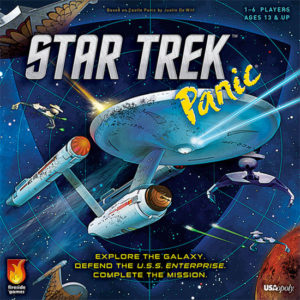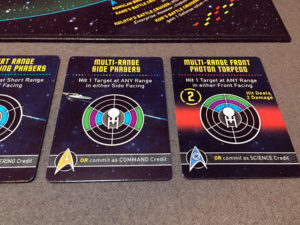 Star Trek: Panic isn’t the first game in the Panic Series (see Castle Panic). Heck, it’s not even the second (see Dead Panic). But it is the first time we’ve seen a license added to the familiar Panic mechanics. And I’m always wary about licensed games.
Star Trek: Panic isn’t the first game in the Panic Series (see Castle Panic). Heck, it’s not even the second (see Dead Panic). But it is the first time we’ve seen a license added to the familiar Panic mechanics. And I’m always wary about licensed games.
Sometimes they can be fantastic (Firefly, WWE Superstar Showdown) and other times they can be nothing more than a cheap cash grab (World War Z). So where exactly does Star Trek: Panic fall into this spectrum, and more importantly, is it fun? Let’s find out.
Star Trek: Panic is a cooperative game for 1-6 players that takes about 60-90 minutes to play.
Game Overview:
In Star Trek: Panic, players must work together to guide the U.S. Enterprise through its five-year journey. Each player will take on the role of one of the iconic crew members of the Enterprise, each with their own special ability.
Each round players will be fighting off threats to the ship, maneuvering the enterprise, and possibly playing cards to try to complete a mission. If the players can compete five missions before the Enterprise is destroyed, they win!
Game Components:

The highlight of the components in Star Trek: Panic has to be the 3D Enterprise model. Of course, this is the classic Enterprise from the original series (sorry next-gen fans). Regardless of your series loyalty (Deep Space 9 all the way!), the ship just looks really cool once it’s assembled. And as a nice touch, it will even fit in the box when you’re done with the game without having to break it back down.
Star Trek: Panic also comes with a variety of tokens, these range from classic Star Trek threats (Klingons, Romulans, etc…) to damage tokens for the ship. The one issue we had with the tokens is that the shield damage tokens don’t quite fit onto the shields. I have to force them pretty good to get them to stay on the shield. Rumor has it that you can file down the inside of them a bit to get them to slide on properly.
Finally, the game comes with a deck of player cards. These will either allow a player to fire the Enterprise’s weapons (phasers or photon torpedoes), act as a special action card or be used to help complete a mission. There is also a large deck of oversized mission cards. I didn’t count the amount of mission cards, but there should be plenty here to keep the replay value high.
How to Play:
Star Trek: Panic has some pretty intuitive mechanics that should allow players to jump in and start playing relatively quickly. This will be a high level overview of how to play. If you’d like the full rules, you can download a PDF here. Once each player has chosen their favorite Star Trek character to play, and the board is set up with the Enterprise and a few threats, you’re ready to begin.
Starting with the first player, each player takes a turn and resolves all the following steps:

1. Draw: Draw up to your hand limit (depending on the player count).
2. Reveal New Mission: If there is not an active mission, draw the next one and go through its setup steps.
3. Trade a Card: You may swap a card with another player.
4. Play Cards and Maneuver: The active player may play as many cards as they like. These range from shooting threats on the board with the Enterprise, to repairing the Enterprise to playing cards onto the mission.
The player may also make one maneuver with the enterprise, either turning it one degree or “moving the ship forward” one space.
5. Check Missions Status: If the mission is complete, claim the rewards, if not, move the timer one space. If it gets to the end of the timer track and the mission is not compete, the mission is failed and discarded.
6. Threats Move and Fire: All threats on the board move one space towards the Enterprise and fire on the ship. If a threat moves onto the Enterprise’s space, it becomes a boarder. Each of the Enterprises’s 6 sections can take 2 hits to its shield, and 2 hits to its hull (shields first). After 3 or more hull sections have been destroyed, the Enterprise can no longer maneuver.
7. Draw New Threats: Two new threat tokens are drawn from the bag and placed on the board. These are usually enemy ships, but sometimes they are events.
If all six sections of the Enterprise’s hull are ever destroyed, the game ends immediately and the player’s lose. Players can also lose if the draw deck is ever empty and there are no cards left in the discard deck to reshuffle.
Rounds will continue in this manner until players complete their fifth missions, in which case they win!

Game Experience:
Of all the Panic games I’ve played, Star Trek: Panic is easily my favorite of the bunch. I’d say it’s definitely the most refined of the Panic systems and if you were trying to decide which one of them to get, this is the one I would suggest.
But on to the big question. How does this work as a licensed game? I’m happy to report that Star Trek: Panic is able to stand on its own merits and is a really fun game. While it’s Star Trek theme is definitely going to draw in some players based on that alone, it also doesn’t rely on the license as a crutch.

First, there are some nice thematic touches that many Star Trek fans can appreciate. The character roles are an obvious nod to their roles on the ship. Scotty is good at repairing the ship, while Sulu is good at driving it. Klingon ships can cloak and cause mischief, while Thornians will throw up their webs to entangle the Enterprise. It’s those thematic touches that help tie the game to its source material. In fact, I even downloaded a Star Trek Soundboard onto my phone to make a phaser sound every time we fired a weapon. It just felt like the right thing to do.
For the actual gameplay, Star Trek: Panic almost feels like a giant puzzle that needs to be solved. There are a lot of moving parts in the game, and players must perform a juggling act using the cards in their hand. Many cards have multiple uses (hooray for multi-use cards!), so some decisions will have to be made on how to use a card. Do I shoot this battle cruiser with a photon torpedo, or play it into the mission to hopefully get us closer to winning? I guarantee that there will be many times you will have a hard time deciding the best way to use a card.

And for players who like to diving into multi-turn strategy, you will really enjoy Star Trek: Panic. More than once my group was planning out a few player turns in a row: “I’ll fix this and destroy that ship, and then when you go, you can pass your Dilithum card to her, so she can repair the hull on her turn.” As this is a cooperative game, open discussion will be necessary if you hope to win. While this kind of open information can sometimes lead to an alpha player taking charge, it was never really an issue in our plays of Star Trek: Panic.
Unfortunately, not everything in Star Trek: Panic is perfect. Beside the above mentioned component issue with the shield tokens, my biggest complaint has to be with some of the mission cards. Sometimes they are a bit too random for my liking. One mission had us waiting for a certain ship to show up. We had 8 rounds for it to happen, but as there are only 3 of those ships in the entire game, there was a very real chance it might never appear in time. It wasn’t very enjoyable having to wait on a mission and hope we drew a random token from the bag.
I may just banish a few of the missions I really don’t like to the box with the “all for nothing” mythos card from Eldritch Horror. Fortunately, many of the missions aren’t like that and the stack is large enough that players will never notice if one or two were to leave the game.
Final Thoughts:

I really enjoyed Star Trek: Panic, much more than I expected actually. I was originally drawn in by the cool looking space ship, but the mechanics ended up being really solid and the game has a nice amount of player interaction.
Players absolutely have to work together in Star Trek: Panic as there is just too much to do for one player to be the lone wolf. That’s what I want from my cooperative board games. Give me a great challenge that requires teamwork and maybe some planning to overcome. If you can do that, then I’m a happy camper. Star Trek: Panic ended up being a great use of the Star Trek license. I’ll be keeping this one in my collection and am looking forward to expansions in the future.
If you’d like to pick up a copy of Star Trek: Panic, you can get it for about $40.
Final Score: 4 Stars – A great use of the Star Trek license and easily my favorite of all the Panic games so far.
 Hits:
Hits:
• Good use of the Star Trek license
• Enjoy the multi use cards and decision-making required
• Good cooperation required to win
• 3D Enterprise looks great
Misses:
• Some missions feel too random
• Shield tokens don’t quite fit on the shields
























A prior Panic license used Pathfinder, which didn’t change the game much.